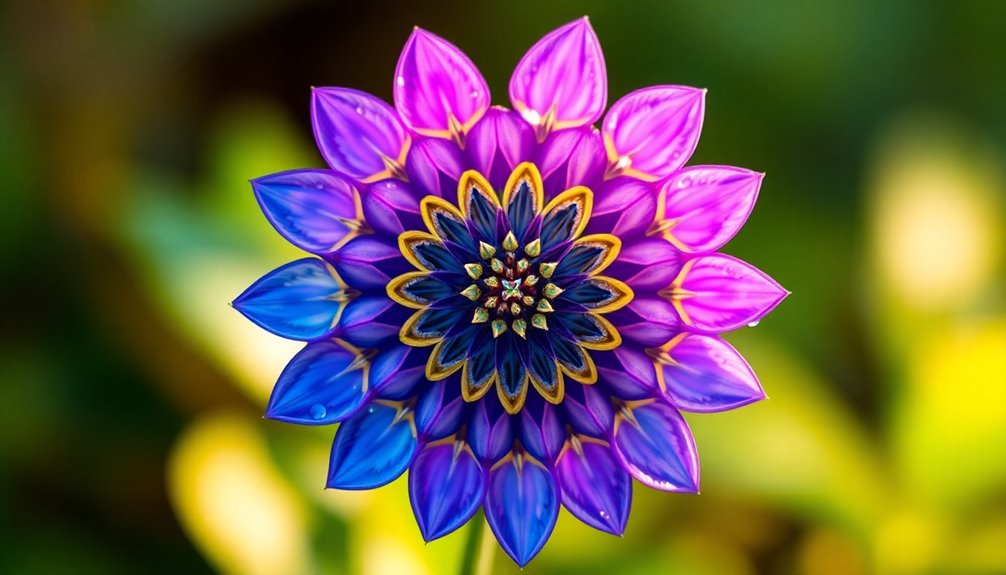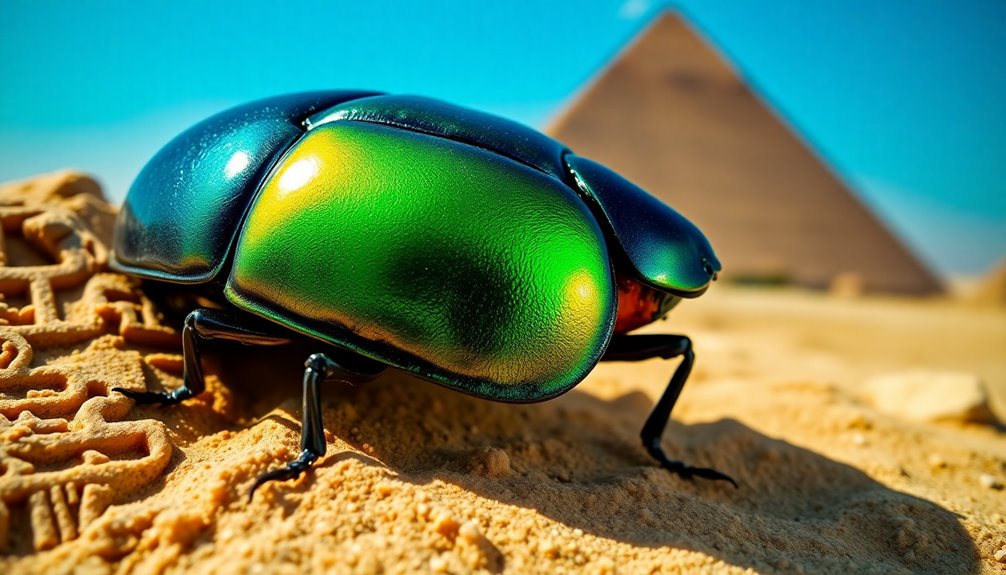You're likely hearing a lot about the mesmerizing 3D Flower of Life, and it's no surprise. This intricate design, made from 19 interconnected circles, symbolizes the unity and interconnectedness of all life. It's rooted in ancient cultures, appearing in temples across Egypt and Greece, and connects deeply with spiritual practices today. People use its geometric beauty in art, meditation, and holistic healing. The 3D representation enhances its visual impact, inviting contemplation. If you want to uncover even more about this enchanting symbol and its significance, there's much more to explore!
Key Takeaways
- The 3D Flower of Life visually represents interconnectedness, enhancing its appeal as a symbol of unity and harmony in modern design.
- Artists and designers utilize 3D interpretations to explore geometric precision and spiritual themes, making it popular in contemporary art.
- The depth and dimensionality of 3D designs amplify the Flower of Life's meditative qualities, inviting deeper contemplation and connection.
- Incorporating vibrant colors and reflective materials, 3D representations engage viewers and enhance the visual impact of this sacred symbol.
- The 3D Flower of Life is celebrated in online communities, fostering discussions and experiences related to spiritual growth and holistic practices.
Overview of the Flower of Life
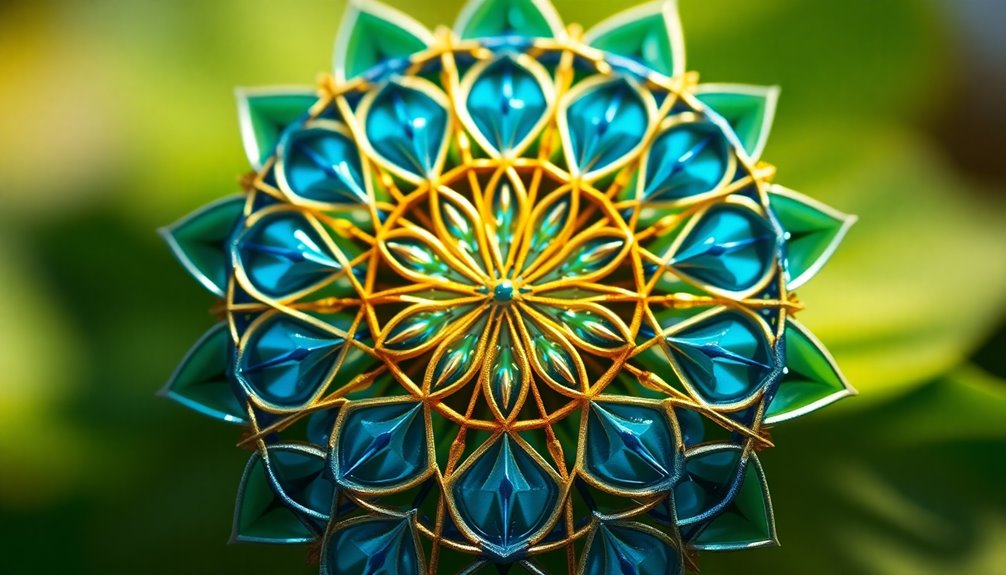
The Flower of Life is a fascinating sacred geometry figure made up of 19 interconnected circles. This intricate design symbolizes the unity and interconnectedness of all life forms, serving as a reminder of the bonds that tie everything together.
Derived from the simpler Seed of Life, which consists of 7 circles, the Flower of Life expands on this concept by duplicating the Seed six times to form its complex structure.
You'll find that the Flower of Life acts as a powerful symbol in meditation and spiritual practices. It's often used to open deeper awareness and expand consciousness, allowing you to tap into a greater understanding of existence.
In numerology, the number 19 simplifies to 1, representing new beginnings and the essence of oneness—qualities that resonate deeply with those seeking personal transformation.
Globally recognized, the Flower of Life appears in ancient temples and modern crop circles across various cultures, showcasing its universal significance in sacred geometry.
When you explore this mesmerizing figure, you're not just looking at art; you're engaging with a symbol that has inspired countless individuals throughout history.
Historical and Cultural Significance
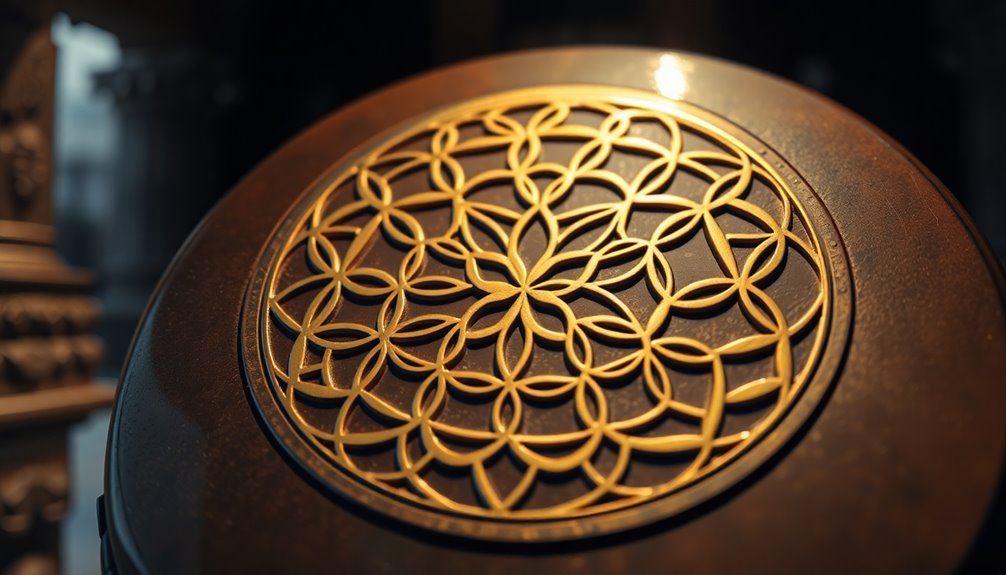
Throughout history, various civilizations have embraced the Flower of Life as a profound symbol of harmony and balance. You'll find this enchanting design in historical artifacts across Egypt, Greece, and India, where it has been revered for its spiritual and geometrical significance. For instance, it graces the temples of Egypt and ancient manuscripts, reinforcing its universal appeal.
The Flower of Life isn't just an artistic motif; it embodies the interconnectedness of all life. Ancient texts often reference geometric principles associated with the symbol, linking it to divine creation and the underlying order of the universe. This connection resonates with many, showing that cultures across time have recognized a common thread in their understanding of existence.
In modern times, figures like Drunvalo Melchizedek have revived interest in the Flower of Life through works like "The Ancient Secret of the Flower of Life." Its presence continues in contemporary art and even crop circles, demonstrating its enduring influence as a universal symbol of creation and consciousness.
Mathematical Properties and Patterns
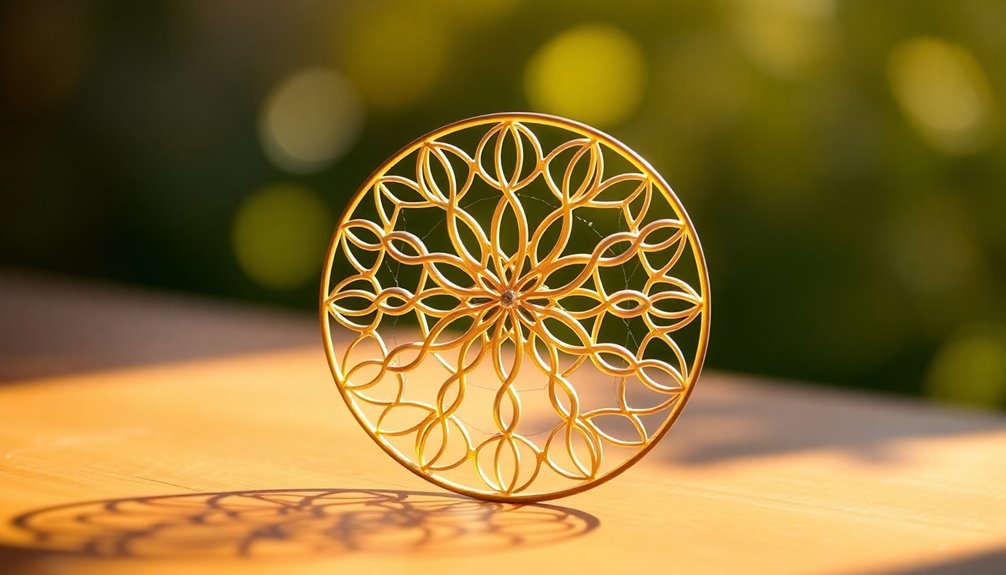
Exploring the mathematical properties of the Flower of Life reveals a fascinating world of intricate patterns and relationships. At its core, this geometric design is constructed from 19 circles, derived from the Seed of Life through duplication and arrangement. This setup illustrates complex mathematical properties, including the presence of the vesica piscis, which encompasses square roots of 2, 3, and 5, forming angles of 30, 60, and 90 degrees.
You can utilize each circle's radius to determine the overall area of the Flower of Life, emphasizing concepts of symmetry and proportion. This geometric masterpiece visually represents the five Platonic solids, foundational shapes in sacred geometry that connect geometry to the elemental forces of nature.
Moreover, the intricate patterns of the Flower of Life lead to deeper insights into fractals and sacred geometry, showcasing the interconnectedness of mathematical structures and the natural world.
Symbolism and Spiritual Connections
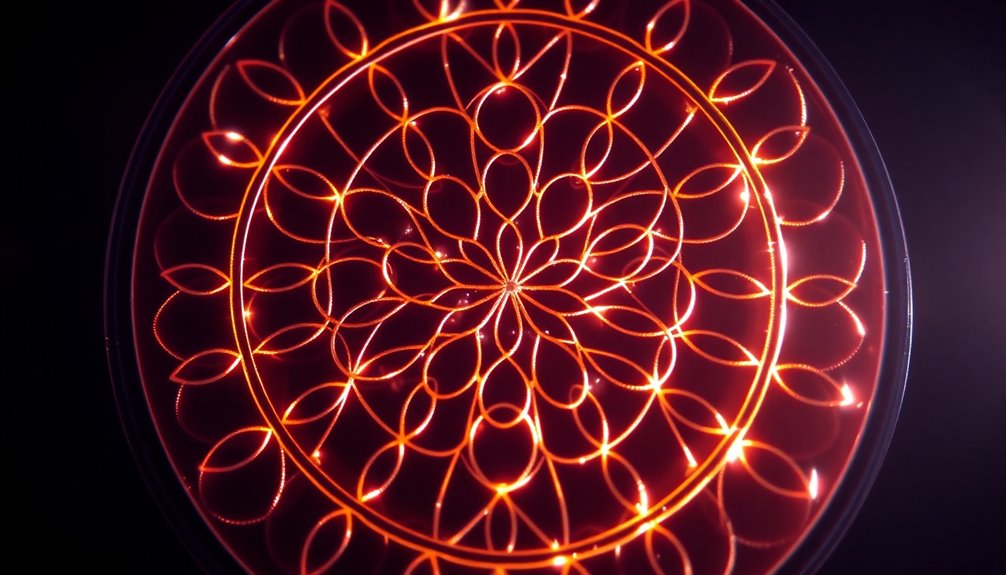
Often regarded as a profound symbol of unity, the Flower of Life embodies the interconnectedness of all living things. Composed of 19 interconnected circles, it represents the unity of creation, where each circle signifies a part of the whole. In numerology, the number 19 reduces to 1, symbolizing new beginnings and the essence of unity within the universe.
The Flower of Life also aligns with the seven chakras, emphasizing its role in spiritual connections and energy flow. It's no surprise that this sacred geometric shape has appeared in ancient cultures like Egypt and India, highlighting its universal significance as a symbol of harmony.
Engaging with the Flower of Life through meditation can reveal deeper spiritual insights and foster a sense of oneness with the universe.
| Aspect | Description | Symbolism |
|---|---|---|
| Circles | 19 interconnected circles | Unity and interconnectedness of life |
| Numerology | Number 19 simplifies to 1 | New beginnings and creation |
| Chakras | Aligns with seven chakras | Spiritual energy and consciousness |
| Cultural Significance | Found in ancient sites across cultures | Harmony and balance in diverse traditions |
Dive into its symbolism and connect with your spiritual essence!
Modern Interpretations and Uses

In today's world, the Flower of Life has evolved beyond its ancient roots, finding a prominent place in modern spiritual practices and artistic expressions.
You'll notice its immense popularity in new age spirituality, where it's often used in meditation to enhance spiritual awareness and connection. Many holistic healing practices incorporate this symbol, believing its sacred geometric properties promote well-being and personal growth.
Artists and designers love using the Flower of Life in their creations because its intricate design resonates with themes of harmony and interconnectedness.
You might even spot it in workshops and educational settings, where it serves as a powerful teaching tool for sacred geometry and sparks creativity among participants.
Contemporary interpretations of the Flower of Life extend into the domain of manifestation as well. Practitioners often use it as a focal point for setting intentions and achieving personal goals, harnessing its energy to guide their aspirations.
3D Representation and Visual Appeal
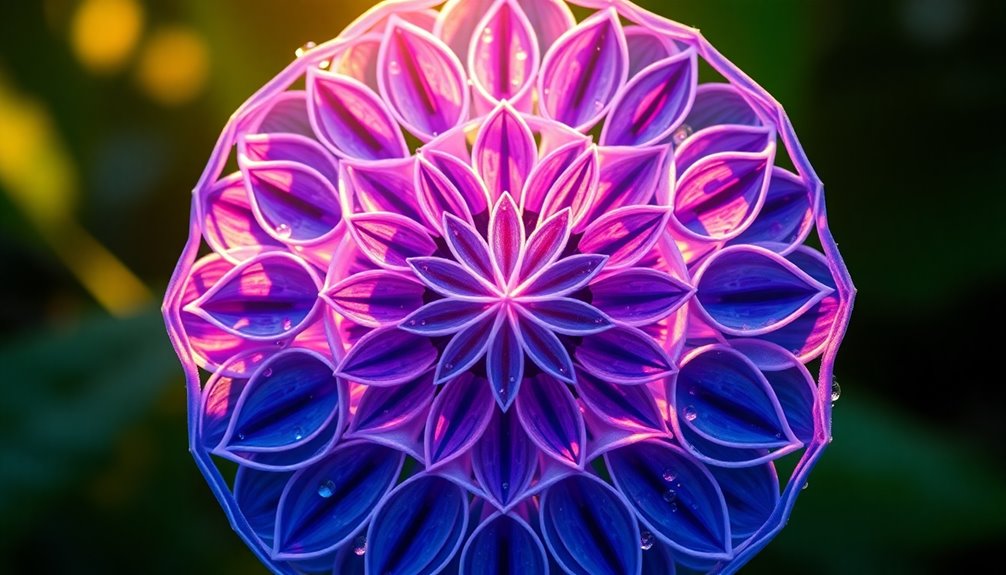
When you explore the 3D Flower of Life, you'll notice how depth perception techniques enhance its visual appeal.
By playing with color and light effects, this design transforms into a dynamic experience that captures your attention.
These elements work together to elevate the beauty and significance of this intricate pattern.
Depth Perception Techniques
Exploring depth perception techniques in the context of the Flower of Life reveals how its intricate geometric structure fascinates the viewer. The arrangement of 19 interconnected circles enhances depth perception and evokes a striking sense of three-dimensionality. You might notice how this design appears to pulsate or move, engaging your visual perception.
To help illustrate the concepts, consider the following table:
| Technique | Effect |
|---|---|
| Overlapping Circles | Creates smaller shapes, adding complexity |
| Golden Ratio | Establishes harmonious proportions |
| Symmetry | Enhances visual appeal |
Artists and designers often harness these depth perception techniques to make their work more engaging. The overlapping circles generate shapes like the Seed of Life and the Egg of Life, which contribute to the overall visual depth. By understanding these techniques, you can appreciate how the Flower of Life design elicits an emotional response and keeps your attention. Ultimately, the mesmerizing beauty of this pattern lies in its ability to transform flat images into a fascinating three-dimensional experience.
Color and Light Effects
The interplay of color and light in the Flower of Life design amplifies its visual charm and spiritual resonance. As you explore its intricate pattern of 19 interconnected circles, you can't help but feel a sense of harmony and balance. The careful selection of colors can evoke various emotions, from tranquility to passion, making it a versatile tool in artistic expression.
When illuminated, the Flower of Life transforms into a fascinating spectacle. Light interacts with its geometric structure, creating stunning optical effects that highlight its sacred geometry. This dynamic relationship between color and light not only enhances its aesthetic appeal but also deepens its meditative quality.
Artists and designers often employ different color palettes to resonate with specific energies, ensuring that the Flower of Life remains a powerful symbol across various settings. By utilizing reflective materials or innovative light projections, they can further amplify its visual impact, making the Flower of Life a striking centerpiece in art and architecture.
Whether you encounter it in a serene meditation space or a lively gallery, the vibrant colors and shimmering light will certainly draw you in, inviting contemplation and connection.
The Flower of Life in Art
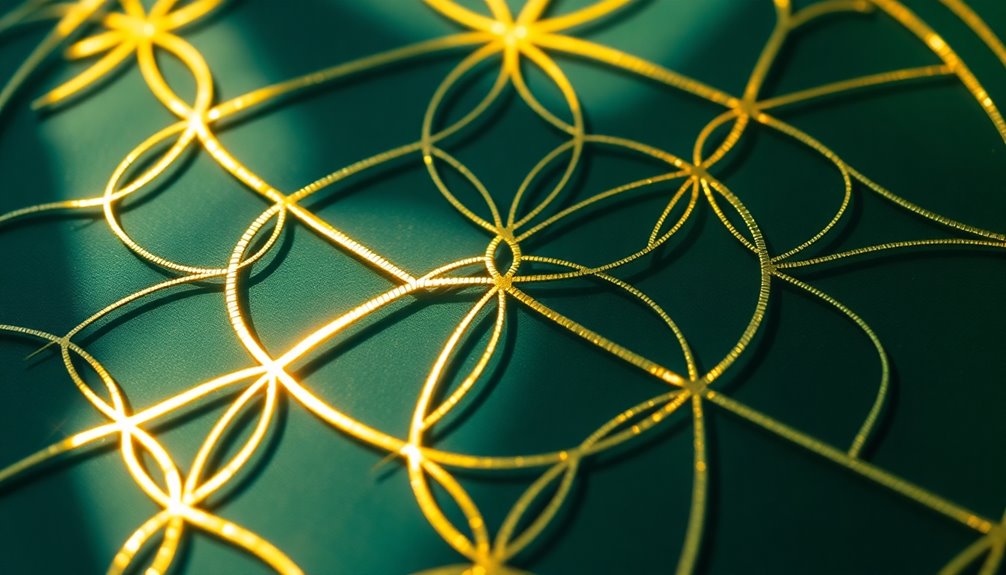
The Flower of Life appears across various artistic interpretations, each reflecting unique cultural influences and symbolism.
As you explore modern applications in design, you'll notice how artists infuse this geometric pattern into everything from tattoos to architectural spaces.
Its presence not only enhances visual aesthetics but also connects deeper themes of unity and existence.
Artistic Interpretations and Styles
Art lovers and spiritual seekers alike find themselves drawn to the Flower of Life, a symbol that transcends artistic boundaries. You'll notice this enchanting design appears in various artistic styles, from intricate mandalas to minimalist interpretations. Its versatility allows artists to express themes of spirituality and interconnectedness in unique ways.
Contemporary creators often incorporate the Flower of Life into their work, exploring consciousness and unity through its geometric precision. Renowned figures, like Leonardo da Vinci, admired its mathematical beauty, recognizing its connection to nature's underlying principles.
In modern art, you'll frequently see the Flower of Life featured in psychedelic and visionary pieces, emphasizing its meditative qualities and the exploration of altered states.
Beyond canvas and paper, this symbol seamlessly integrates into jewelry and fashion design, serving as both an aesthetic element and a representation of holistic lifestyles.
The Flower of Life's appeal lies in its ability to resonate on multiple levels, inviting you to explore not just the visual beauty but also the deeper spiritual connections it embodies. As you engage with this symbol, you'll discover the myriad ways artists interpret and celebrate its significance in art. Additionally, embracing curiosity and happiness can enhance your appreciation of the Flower of Life and its artistic representations.
Cultural Influence and Symbolism
Across cultures and throughout history, the Flower of Life has served as a powerful symbol, representing harmony and the interconnectedness of all living things.
You'll find this mesmerizing geometric pattern in ancient art and architecture from civilizations like Egypt, Greece, and India. Its presence in sacred sites, such as temples and cathedrals, not only enhances the spiritual ambiance but also reflects the principles of sacred geometry.
The cultural influence of the Flower of Life extends beyond ancient times. Artists and designers today often integrate it into modern artwork, showcasing its aesthetic appeal while expressing deeper spiritual themes.
This symbol resonates with many, aligning with the seven chakras and inspiring contemporary spiritual and wellness practices, including meditation and holistic healing.
Its allure doesn't stop there; the Flower of Life appears in crop circles and popular media, sparking curiosity and inviting exploration into its profound meanings.
Modern Applications in Design
Incorporating the Flower of Life into modern design creates a mesmerizing blend of aesthetics and meaning. This emblem of sacred geometry is visually striking, offering patterns that evoke harmony and balance.
You'll find it frequently featured in contemporary design, where artists explore its intricate forms to express unity and interconnectedness. It's a popular choice for branding and logos, appealing to spiritual and holistic markets looking for deeper significance.
When you see the Flower of Life in textiles, wallpapers, or home decor, its calming effect enhances the visual experience, making spaces feel more harmonious.
In digital art, this pattern serves as a foundation for fractal designs, enabling you to manipulate its geometric forms into mesmerizing visual effects.
Contemporary graphic design often reflects themes of mindfulness and spirituality, resonating with audiences seeking connections that go beyond the surface.
Whether it's in a logo, a piece of furniture, or a stunning wall mural, the Flower of Life continues to inspire and transform modern art and design, inviting you to appreciate the beauty of sacred geometry in everyday life.
Personal Reflections and Experiences
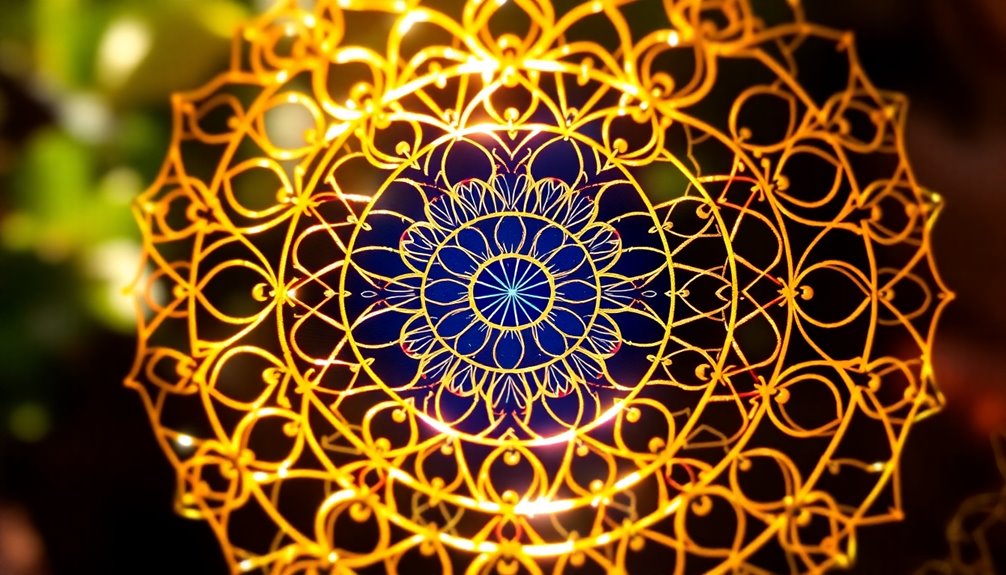
Many people find that reflecting on the Flower of Life brings a profound sense of peace and interconnectedness. When you meditate on its intricate patterns, you might feel a deep connection to the universe and a greater understanding of your place within it. This process often leads to valuable personal reflections, allowing you to examine your feelings and thoughts more openly.
As you investigate the symbolism and numerology of the Flower of Life, you may uncover insights that inspire your spiritual growth. Many individuals describe their journeys as transformative, noting how this sacred geometry enhances mindfulness during meditation. It serves as a powerful visual tool, guiding you to a heightened spiritual awareness.
Engaging with online communities can amplify these experiences, as you share your insights and learn from others. By participating in discussions and exploring resources related to the Flower of Life, you can deepen your understanding and find personal significance in its beauty.
Ultimately, these reflections can lead you to a richer appreciation of your spiritual journey, fostering a sense of unity with all living things and encouraging continuous growth.
Exploring Further: Resources and Communities
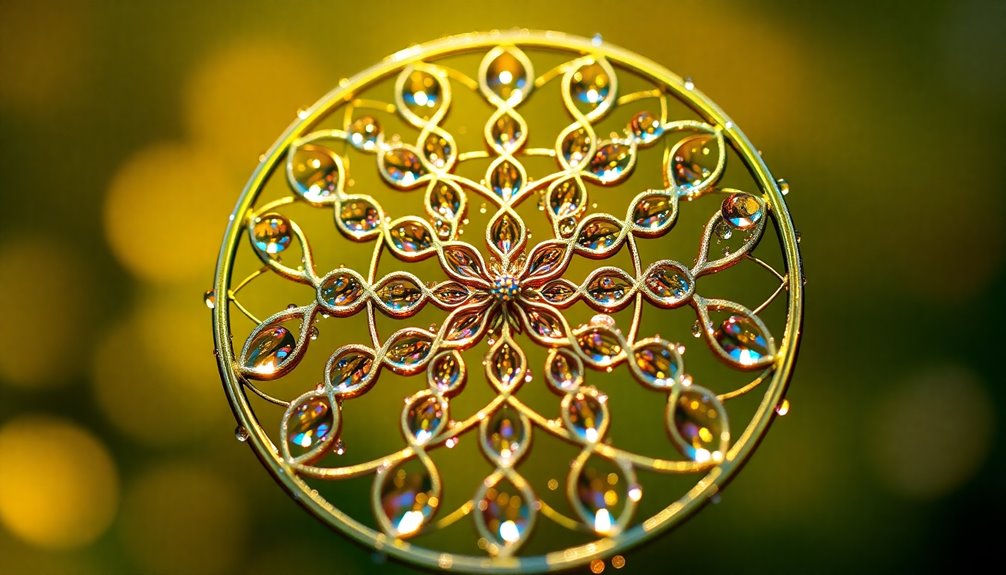
As you dive deeper into the world of the Flower of Life, numerous resources and communities await to enrich your understanding and experience.
These platforms not only provide valuable information but also connect you with like-minded individuals passionate about sacred geometry.
Here are three key resources to contemplate:
- Books and Literature: "The Ancient Secret of the Flower of Life" by Drunvalo Melchizedek is a must-read. It explores the significance of the Flower of Life across cultures and is foundational for anyone interested in sacred geometry.
- Online Forums and Social Media Groups: Engaging in online communities can enhance your learning. These platforms allow for rich discussions, sharing of personal experiences, and the exploration of various interpretations of the Flower of Life.
- Workshops and Classes: Look for local workshops that focus on sacred geometry. These hands-on classes often include artistic and meditative practices, allowing you to experience the Flower of Life in a tangible way.
Frequently Asked Questions
What Is the Meaning Behind the Flower of Life?
The Flower of Life symbolizes the interconnectedness of all life and the universe.
When you explore its 19 circles, you'll find they represent creation and unity. This geometric pattern aligns with the seven chakras, emphasizing its spiritual significance.
What Is the Mystery Behind the Flower of Life?
The mystery behind the Flower of Life often sparks curiosity about its deeper meanings.
You might investigate its sacred geometry connections, revealing how it symbolizes oneness and interconnectedness.
The pattern's 19 circles, aligning with the seven chakras, suggest a universal language that transcends cultures.
As you explore its historical significance across various civilizations, you'll uncover how it continues to inspire spiritual awakening and a profound understanding of existence, connecting you to the cosmos.
What Is the Quote About the Flower of Life?
When exploring quotes about the Flower of Life, you'll find many resonate deeply with its symbolism.
One powerful quote states, "The Flower of Life is the blueprint of creation." This reflects its essence of interconnectedness and unity.
As you investigate its meaning, you'll discover how this geometric shape encapsulates the universe's creative force, reminding you of your connection to all life and the potential for new beginnings within you.
What Is the Flower of Life Visualization?
The Flower of Life visualization involves focusing on the intricate pattern of overlapping circles, which represents the interconnectedness of all existence.
As you meditate on this geometric design, you deepen your awareness of the universe and your place within it. You might visualize the circles expanding and contracting, aligning with your energy centers, or chakras.
This practice can enhance your spiritual growth, offering insight into the fundamental nature of creation and your connection to life itself.
Conclusion
As you explore deeper into the enchanting world of the Flower of Life, you might begin to sense its pull in your own life. What mysteries could it reveal for you? With its rich history and profound symbolism, this geometric wonder invites you to investigate not just its patterns, but also your connection to the universe. So, are you ready to uncover the secrets it holds? The journey is just beginning, and who knows what you might discover next.
